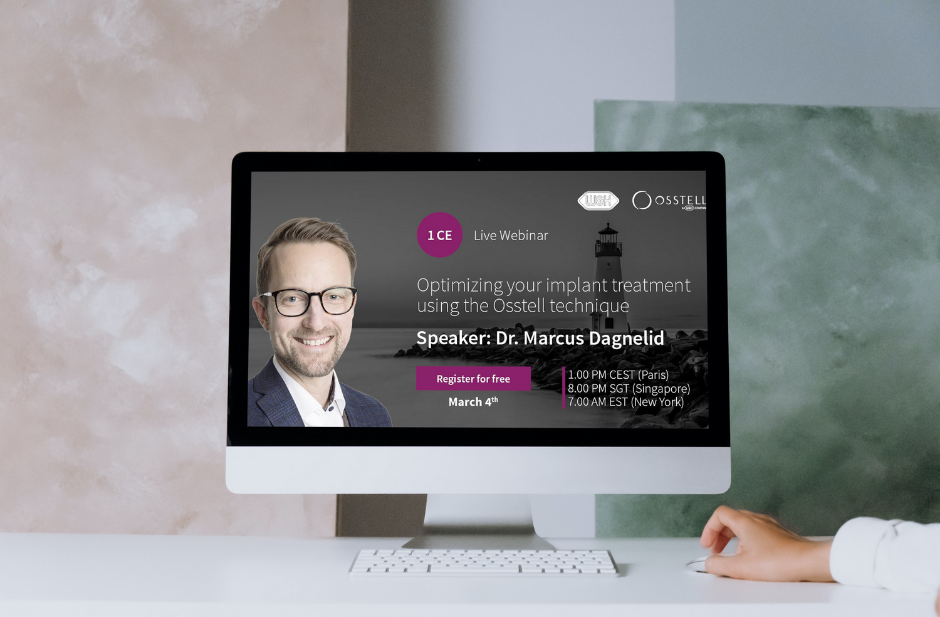
On March 4th, Dr. Marcus Dagnelid held a webinar on our educational platform Osstell Campus where he spoke on the topic “Optimizing your implant treatment using the Osstell technique”. The learning objectives from this lecture is to understand the importance of objective measurements in the clinical decision-making process surrounding dental implant patients, how to utilize the RFA technique in immediate loading protocols, and help clinicians improve their knowledge in how they can track patients and treatment outcomes by the use of Osstell Connect online platform.
A great amount of questions came in during the interactive Q&A session, and Dr. Dagnelid has in this blog post answered them all for you.
Dr. Dagnelid, what is the protocol to be followed if ISQ is low at the time of placement?
Dr. Marcus Dagnelid: With a very low number, choose a two-stage approach with cover screw.
In a 2 stage case. What is the lowest ISQ you would restore at?
Dr. Marcus Dagnelid: It depends on the case. For a single implant 70 as the lowest ISQ number, splinted implants minimum 65.
How do I select the correct peg to take an ISQ measurement?
Dr. Marcus Dagnelid: There are specific for each implant system, please see the Osstell SmartPeg Reference Guide.
Is there a low limit, where you can assume there is no osseointegration? For example the lowest value I measured was 8. Is there a chance to wait for higher value?
Dr. Marcus Dagnelid: 8 would be a wrong number meaning not seated peg. Look for a decrease in value from time of implant placement and follow-up, those are the ones to be careful with.
So if you’ve measured ISQ and not above 70, are you using a new peg each time you recheck ISQ until you achieve a value over 70 every 3-4 weeks?
Dr. Marcus Dagnelid: Yes, a new SmartPeg for each time.
Is OsstellConnect easy to learn how to use?
Dr. Marcus Dagnelid: Yes, it is very intuitive and easy to use for all team members.
Hello, thanks for a great lecture! Can other Clinicians see my patients and my data in OsstellConnect?
Dr. Marcus Dagnelid: No, but you can share ideas and discuss with colleagues around the world.
In full mouth implants, are we using the abutment level ISQ, how does this work?
Dr. Marcus Dagnelid: A specific peg for abutment level.
Was it easy for your Staff to learn how to use OsstellConnect?
Dr. Marcus Dagnelid: Yes, very easy.
When the ISQ-Value is below 70, when do you submerge and when do you use a transgingival approach?
Dr. Marcus Dagnelid: I submerge if the ISQ value is below 65.
Does additional work in the planning in the platforms including OsstellConnect increase your productivity?
Dr. Marcus Dagnelid: Yes, it brings you closer to the patient and greater case acceptance.
What are the advantages and disadvantages of OsstellConnect compared to other platforms? To add all that extra data in yet another place.. isn’t it even more time consuming?
Dr. Marcus Dagnelid: No, the alternative is paper or other software, this is much easier and efficient plus it keeps track on all your implant patients at one place. You can communicate with referrals and other team members as well.
Do you utilize Osstell selectively or for all of your implant cases?
Dr. Marcus Dagnelid: All case from the time of implant placement.
How long have you been working with digital technology for your implant treatments?
Dr. Marcus Dagnelid: For more than 15 years.
Are Torque and ISQ always the same? Can you obtain a high ISQ yet have recorded a low torque value on insertion? Is there a direct correlation between the two?
Dr. Marcus Dagnelid: ISQ is correlated to degree of micromotion. There is a misconception that you need very high torque values to obtain good ISQ numbers. With a torque of 25 Ncm, ISQ values can be as high as 70. See studies by P.Trisi and co-workers.
Will sterile plastic sleeve placed over beacon device used when placing implant affect ISQ value?
Dr. Marcus Dagnelid: No, it won’t.
What ISQ will lead you to do 2 stage surgery?
Dr. Marcus Dagnelid: Below 65.
What is your experience history with Osstell ISQ? How long have you been using Osstell in your practice?
Dr. Marcus Dagnelid: I have been using it for 18 years.
Would you immediately load an implant without ISQ values?
Dr. Marcus Dagnelid: No, this is the true objective value that determines loading protocol.
Hello Dr, my question is: how accurate is the ISQ value? Can it always be trusted?
Dr. Marcus Dagnelid: Yes, more than any other measurement.
What happens when you can’t seat the peg despite the healing abutment seating fine. Presumably the ISQ won’t be accurate? Check PA XR showed peg not seated.
Dr. Marcus Dagnelid: This usually means debris inside the implant or wrong peg.
What ISQ value should the Beacon show for you to feel confident about placing an implant? (immediate loading)
Dr. Marcus Dagnelid: 70 and above.
How confident are you in the accuracy of Osstell ISQ measurements?
Dr. Marcus Dagnelid: Extremely confident with more than 1300 studies published on the topic.
I had a situation today when placing an implant in an osteoporotic patient on Prolia with Type III-IV bone whereby the torque of the implant was about 20Ncm at placement but when the Osstell was used to measure the stability. I got a value of 73/73 – checked with 2 separate pegs, then as Osstell value was above 70, placed a HA but implant moved when placed at 15Ncm. Tried to remove HA which removed implant. Then placed another implant, slightly longer. Torque only 10Ncm this time. Beacon showed measure 70:70 – why did osstell measurement show no correlation to torque values?
Dr. Marcus Dagnelid: See studies by P.Trisi and co-workers.
I have had several cases where the is stips at mid 60’s, I’ve torque tested them and there solid. Can I restore or remove? Thanks
Dr. Marcus Dagnelid: Yes, even though I would recommend 70 for a single implant.
If you check the ISQ multiple times for the same patient, would it be more accurate to use the same peg?
Dr. Marcus Dagnelid: New peg for each time.
When you get a value that is less than 60 at 3 to 4 weeks, should you then torque test and remove implant?
Dr. Marcus Dagnelid: No, wait longer and measure again. At 3-4 weeks the stability is at the lowest after placement due to biologic reasons, it will go up when biological stability is achieved. Wait 3 weeks between measurements.
You can watch the webinar on-demand here.

Add comment